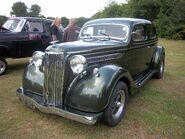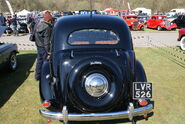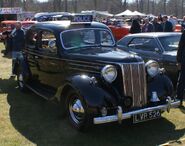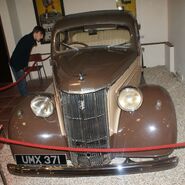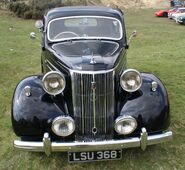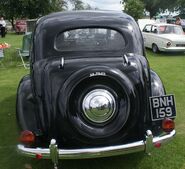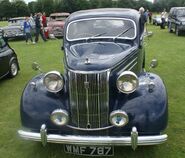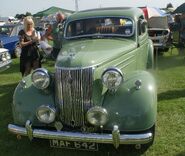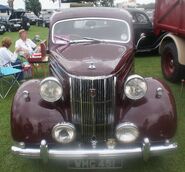
1950 Ford V8 Pilot front view
The Ford Pilot Model E71A was a large car from Ford introduced in August 1947. It was effectively replaced in 1951 with the launch of Ford UK's Zephyr Six and Consul models, though V8 Pilots were still offered for sale, being gradually withdrawn during that year. During the period of manufacture 22,155 cars were produced.
Engine and running gear[]
The Pilot was the first large post-war Ford. It was based on a pre-war 22 hp chassis, and was initially offered with the 2227 cc side-valve engine from the 1939 model. These initial engines were Canadian-made surplus stock from wartime production of Bren gun carriers. The engine was soon replaced: most Pilots were fitted with a more generously powered 3622 cc, 90 hp (67 kW) sidevalve V8 engine, having a stroke of 92.25 mm and bore of 79 mm with single Solex carburettor. This is essentially the same 'low water pump, 21 stud' engine as fitted to the North American 1937 / 38 models, but with an additional frost plug hole cast into the rear of each cylinder bank. This engine was also used in Thames trucks. Sadly, the car retained 6-volt electrics. The gears were changed by means of a gear lever on the steering column; the gearbox itself had three forward ratios and one reverse. Steering used a form of worm and roller system known as a Marles steering box with an "hour-glass cam and a double roller". The car was evidently seen as rather old-fashioned even at the time, but its front brakes were hydraulically-controlled.The rear brakes were cable-operated.
Most Pilots were four-door saloons, but Estate and pick-up versions were produced, the latter for the export market only. The front windscreen could be opened for ventilation pivoting about a top hinge. Production ended in 1951 when the Pilot was replaced by the Ford Zephyr.
Like other Fords of the era, the Pilot used vacuum-driven wipers taking their power from the engine manifold; as a result they tended to slow drastically or even stop when full throttle was used under load. The car was reputed to be capable of 80 mph (130 km/h) and have a 0 to 60 mph (96 km/h) time of 21 seconds and return 18 miles per imperial gallon (16 L/100 km; 15 mpg-US).
Australian assembly[]
Importation and local semi-assembly of the Pilot (along with the 1949 US Ford V8) by the Ford Motor Company in Australia in 1949 was essential in countering the retail sales of the new government-financed General Motors-Holden's 'Holden' which began in February of that year. In fact the Pilot was sold new in Australia until well into the 1950s.
Such importation (along with that of the Ford Prefect and Anglia) was essential in maintaining a presence in that country after a refusal by the then-Federal Government to provide any direct financial assistance to produce a local car (this despite Ford providing a more detailed and comprehensive proposal than GMH, and despite the fact that many millions of pounds had been invested by Ford US in Australian vehicle assembly plants since 1925).
Competition[]
The Pilot achieved some sporting success and Ken Wharton drove one to victory in the 1950 Tulip Rally and Lisbon Rally.
Gallery[]
| Ford of Britain vehicles | ||
|---|---|---|
| Ford | ||
| Classic production cars | 1900s | Model T |
| 1910s-1920s | Model A | |
| 1930s-1940s | Model B • Model Y • Model 48 • Model 91 • Model C Ten • Model 7W • Model 7Y • Prefect • Anglia • Pilot | |
| 1950s | Consul • Popular • Squire • Zephyr | |
| 1960s | Capri • Corsair • Classic • Cortina • Escort • GT40 | |
| 1970s | Granada | |
| 1980s | Orion • RS200 • Sierra • Sierra RS Cosworth | |
| Classic commercial vehicles
|
A-Series • Model AA • Model BB • Model TT • Cargo • D-Series • E83W • R-Series • Thames 300E • Thames 307E • Thames 400E • Thames 7V • Thames ET • Transcontinental • Transit • Trader | |


